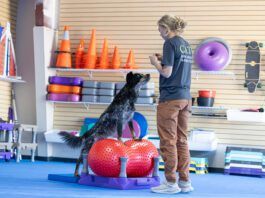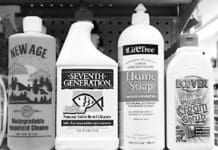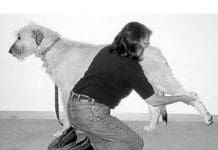Moving Blues
For the last three years, Bailey (my six-year-old Chow/Shepherd mix) and I have been living with my boyfriend and Colleen (his eight-year-old Norwegian Elkhound)....
The Force MAY Be With You
I wanted to write you and tell you of an extraordinary experience that I had using homeopathy for my dog. Last summer our seven-year-old Shepherd-mix developed a hard lump near her shoulder. It grew to the size of a large marble. We took her to our vet, who performed a needle biopsy. It came back as reactive lymph tissue – baffling because there should be no lymph tissue in that area. To be safe, he recommended surgery, since a needle biopsy can only test a fragment of the lump. The surgery would have to go deep because the lump was imbedded in her muscle. I took a deep breath, listened to my own inner calm and immediately decided to boost her immune system using the herb astragalus and a maitake mushroom tincture. I also boosted her vitamins.
Veterinary Acupuncture is Becoming Mainstream
It is generally accepted that the practice of human and veterinary acupuncture had their beginnings in ancient China. According to legend, veterinary acupuncture was discovered when lame horses were used for battle and became sound after being pierced by arrows at distinct points. Regardless of the accuracy of the folklore, there is evidence that veterinarians practiced acupuncture around 2000-3000 BC. The early use of the technique on animals was probably prompted by the economic importance of horses, camels, elephants, cows, pigs, and chickens as sources of transportation and food. Now, veterinary acupuncture is used worldwide to treat all types of animals including many exotics.
Dog Training Books
Dogs are a hot topic these days (no pun intended) and it seems that every publisher under the sun has a new dog book to promote. We are thrilled by the number of new books we can choose from to help us expand our knowledge and understanding of our canine pals. But it’s important to be selective when choosing which of the many offerings to bring home. Not all training books are created equal; some promote training methods that are ineffective or even downright cruel, especially in the hands of training novices.
Holistic Veterinarians Take on The Annual Vaccination Schedule
Holistic veterinarians have long decried the annual vaccination schedule recommended by many conventionally trained veterinarians for all dogs. Many holistic veterinarians suspect that many of the complex ailments that plague our modern dogs – from allergies to digestive problems to aggressive behavior and so on – have their roots in immune system problems brought on by excessive and unnecessary vaccination. However, many of us are convinced by our veterinarians that our dogs won’t be safe unless they receive these boosters every year. Fortunately, a recent study indicates that most dogs retain humoral antibody protection from past vaccinations for longer than previously thought.
Proper Use of Head Halters for Leash Training
Ten years ago, a new dog training tool hit the market. Known generically as the head halter (or head collar), it is a device similar to the halter commonly used on horses. It provides a greatly increased degree of control over the dog who is dedicated to pulling on the collar and leash, without the punishment or pain factors associated with choke chains and prong collars. The head halter has a strap that goes around the dog’s nose, and another that clasps around his neck, just behind the ears. The leash attaches to a ring below the dog’s chin. Just like with halters on horses, bulls and other large animals, it works on the principle that where the nose goes, the body must follow.
Homeopathy: An Alternative Theory of Medicine
In the late 1700s, a German physician named Samuel Hahnemann discovered that China, a precursor for the quinine that was being used to treat malaria, actually caused symptoms of malaria when administered to a healthy person. Hahnemann made this discovery while translating a medical text on various drugs. He suspected that the source of China’s curative power had been misunderstood and he decided to give himself small doses of the substance to test his theory. Hahnemann discovered that small doses of China produced in his healthy body malaria-like symptoms that abated after two or three hours. In thus observing that a drug will cause in a healthy person the same symptoms it cures in a sick one, Hahnemann gained the key insight that drugs cure diseases to which they bear marked similarities.
Dog Poop and the Environment
In previous issues Whole Dog Journal reviewed products designed to make picking up dog poop easier. We also compared some commercial poop bags
Worthwhile Causes
I am extremely pleased that you chose to not only highlight the sport of agility (my chosen dog sport passion) in the August 2000...
Mastering Canine Massage Skills
Several readers have contacted me with reports of their growing massage skills. Learning and practicing each new massage technique is a thrill, and now that you have accomplished several techniques it is time to put them all together into a massage routine for your dog. The following routine is just a guideline to help get you started. Once you have tried it a time or two, you will naturally sequence the massage moves into a routine to suit you and your dog. Soon each massage will be different and will meet your changing needs and moods.
Do You Have A Prayer?
I am not a really religious person but after a personal experience with our young puppy who was fighting for his life, I know he is alive today because of prayer. We moved a year ago and as Maggie (our other Border Collie/Akita) was to have her own outdoor yard we decided to get her a companion. We looked in the local paper and saw an ad for a person giving away Border Collie/Rottweiler/German Shepherd puppies. We decided to drive out to see the puppies, and by the time we got there, there was only one puppy left. We decided to take him home with us.
Letters (03/00)
I am an enthused reader of Whole Dog Journal; it is the only doggy magazine/journal that I subscribe to and read. I also operate an independent home business delivering high quality pet foods such as Natura, Canidae, and Natural Balance foods. Your continual attention to the quality of products has made me a fan of your work. However, recently you referred to the members of the Association of Pet Dog Trainers as being non-force trainers, and you suggest that readers look to the APDT list for referrals to trainers. As a trainer of pet dogs for 26 years and one that is completely force-free, I can assure you that some members of APDT do use force-based training methods.












